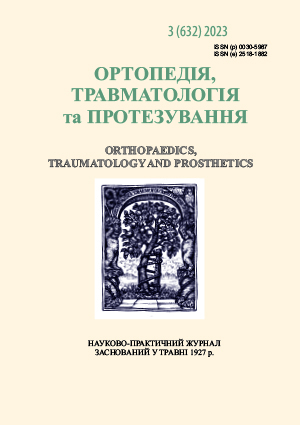BIOMECHANICAL SUBSTANTIATION OF THE ALGORITHM FOR CHOOSING THE OPTION OF DISTAL CORRECTIVE OSTEOTOMY OF THE II–IV METATARSAL BONES IN THE TREATMENT OF METATARSALGIA
DOI:
https://doi.org/10.15674/0030-59872023319-27Keywords:
Metatarsal bone, deformity, corrective osteotomyAbstract
Deformations of the front part of the foot with valgus deformity of the first toe lead to a redistribution of the body weight load during walking between the heads of the metatarsal bones. At the same time, the load on the head of II and III, and sometimes IV metatarsal bones increases significantly. Objective. To substantiate the choice of the most correct distal metatarsal osteotomy for the treatment of patients with metatarsalgia. Materials and methods. Three variants of distal metatarsal osteotomy were simulated: Weil, Helal, and distal wedge-shaped metatarsal osteotomy. Result. Weil osteotomy allows you to raise the support point of the metatarsal head above the support surface from 2 to 7 mm, depending on the amount of displacement of the head in the proximal direction and the angle of inclination of the metatarsal bone relative to the plane of the support surface, which effectively reduces the load on the metatarsal head during walking, but under conditions of magnitude the angle of inclination of the axis of the metatarsal bone is more than 20°. Helal osteotomy with the subsequent displacement of the separated part proximally, ensures the lifting of the head above the conventional plane of support from 1 to 4 mm, contributes to the effective unloading of the head while standing and while walking. They are used only for severe metatarsalgia. The range of correction of the standing height of the support surface of the metatarsal head for performing a distal wedgeshaped osteotomy is determined to be from 0.6 to 2.9 mm. Its advantage is the independence of the amount of correction from the presence or absence of a decrease in the longitudinal arch of the foot. Conclusions. Weil osteotomy has the worst corrective possibilities of raising the head of the metatarsal bone, but is very easy to perform, so its use is advisable in the absence of reduction of the longitudinal arch of the foot. A wedge-shaped distal osteotomy has a range of correction of the metatarsal head
elevation up to 3 mm, but it depends on its diameter, so it is used in the case of a head diameter of at least 10 mm. Helal osteotomy provides the widest range of elevation of the metatarsal head, which does not depend on the presence of any degree of flat feet, but has some technical limitations.
References
- Besse, J.-L. (2017). Metatarsalgia. Orthopaedics & Traumatology: Surgery & Research, 103, S29–S39. https://doi.org/10.1016/j.otsr.2016.06.020
- Nguyen, U.-S. D. T., Hillstrom, H. J., Li, W., Dufour, A. B., Kiel, D. P., Procter-Gray, E., Gagnon, M. M., & Hannan, M. T. (2010). Factors associated with hallux valgus in a populationbased study of older women and men: the MOBILIZE Boston Study. Osteoarthritis Cartilage, 18 (1), 41–46. https://doi.org/10.1016/j.joca.2009.07.008
- Regnauld, B. (1986). The Foot. Springer Berlin Heidelberg. https://doi.org/10.1007/978-3-642-61605-1
- Vincent, J. (1994). Hallux valgus and forefoot surgery. New York: Churchill Livingstone.
- Lelievre. J. (1981). Pathologie du pied (4 th ed.). Paris: Masson.
- Maestro, M., Besse, J.-L., Ragusa, M., & Berthonnaud, E. (2003). Forefoot morphotype study and planning method for forefoot osteotomy. Foot and Ankle Clinics, 8 (4), 695–710. https://doi.org/10.1016/s1083-7515(03)00148-7
- Prozorovskiy, D., & Buznytskiy, R. (2021). Helal and Weil osteotomy in the treatment of metatarsalgia in the conditions of the transverse deformity forefoot. ORTHOPAEDICS TRAUMATOLOGY and PROSTHETICS, (4), 58–63. https://doi.org/10.15674/0030-59872020458-63
- Besse, J. L. (2017). Metatarsalgia. Orthopaedics & Traumatology: Surgery & Research, 103 (1), S29–S39. https://doi.org/10.1016/j.otsr.2016.06.020
- Leemrisje, T., Deleu, P.A., Devos Bevernage, B., & et al. (2014). Weil osteotomy 0.25 years AFCP Monograph. Specialty Days. SOFCOT, Montpellier: Sauramps Medical.
- Khurana, A., Kadamabande, S., James, S., Tanaka, H., & Hariharan, K. (2011). Weil osteotomy: Assessment of medium term results and predictive factors in recurrent metatarsalgia. Foot and Ankle Surgery, 17 (3), 150–157. https://doi.org/10.1016/j.fas.2010.04.003
- Helal, B. (1975). Metatarsal osteotomy for metatarsalgia. The Journal of Bone and Joint Surgery. British volume, 57-B (2), 187–192. https://doi.org/10.1302/0301-620x.57b2.187
- Trnka, H.-J., Kabon, B., Zettl, R., Kaider, A., Salzer, M., & Ritschl, P. (1996). Helal metatarsal osteotomy for the treatment of metatarsalgia: a critical analysis of results. Orthopedics, 19 (5), 457–461. https://doi.org/10.3928/0147-7447-19960501-17
- Muller, T., Dereymaecker, G., Victor, J. & et al. (1994). Longterm functional results after the Helal osteotomy. Foot Diseases, 1, 69–77.
Downloads
How to Cite
Issue
Section
License

This work is licensed under a Creative Commons Attribution 4.0 International License.
The authors retain the right of authorship of their manuscript and pass the journal the right of the first publication of this article, which automatically become available from the date of publication under the terms of Creative Commons Attribution License, which allows others to freely distribute the published manuscript with mandatory linking to authors of the original research and the first publication of this one in this journal.
Authors have the right to enter into a separate supplemental agreement on the additional non-exclusive distribution of manuscript in the form in which it was published by the journal (i.e. to put work in electronic storage of an institution or publish as a part of the book) while maintaining the reference to the first publication of the manuscript in this journal.
The editorial policy of the journal allows authors and encourages manuscript accommodation online (i.e. in storage of an institution or on the personal websites) as before submission of the manuscript to the editorial office, and during its editorial processing because it contributes to productive scientific discussion and positively affects the efficiency and dynamics of the published manuscript citation (see The Effect of Open Access).














